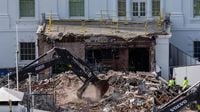In a move that has stunned Washington and ignited fierce debate across the country, President Donald Trump has overseen the complete demolition of the White House’s East Wing—an iconic structure dating back to the early twentieth century—to make way for a massive new ballroom. The $300 million project, already being referred to by officials as “The President Donald J. Trump Ballroom,” is set to become one of the most significant and controversial additions to the presidential residence in modern history, according to reporting by ABC News, NBC News, and other major outlets.
The East Wing, built in 1902 during Theodore Roosevelt’s administration and completed in the 1940s, has long served as the formal entrance for thousands of guests attending state dinners, Christmas parties, and White House tours. It also housed offices for First Ladies and staff, soaking up the aura and history of figures like Jacqueline Kennedy, Nancy Reagan, and Eleanor Roosevelt. Over the decades, it became a symbol of the White House’s understated elegance and the nation’s commitment to public service over grandeur.
But that chapter closed abruptly in late September 2025, when demolition crews began razing the East Wing and the corridor connecting it to the main residence. By October 24, the work was in full swing, with heavy equipment cycling in and out of the grounds. According to CBS News and CNN, the demolition was both swift and sweeping, reducing decades of history to dust and rubble in a matter of days. Onlookers watched as red and gray scrap haulers pulled out of the White House gates, loaded with mangled rebar and remnants of the past, bound for a Maryland scrapyard where the debris would be recycled.
Some efforts were made to preserve history. NBC News reported that former First Lady Rosalynn Carter’s original office has been saved and is likely to be relocated. Yet, not all could be spared—Jacqueline Kennedy’s garden was removed, and portions of the grounds were taken to Hains Point parkland along the Potomac River. The White House also said that some construction debris, including wood and plants, may find new life in nurseries through the National Park Service.
The rationale behind this dramatic transformation is President Trump’s vision for a grand ballroom, one that dwarfs anything previously imagined for the White House. The planned facility, at 90,000 square feet—almost twice the size of the main residence—will be adorned with gold leaf and designed to host large-scale events and parties. Trump, known for branding his construction projects, is expected to name the edifice after himself, although he coyly told ABC News, “I won’t get into that now.”
Funding for the project has come under scrutiny. A White House official confirmed to ABC News that $350 million has been raised, primarily through private donations, including sizable contributions from major corporations like Comcast Corp. (the parent company of NBCUniversal). While construction costs are currently estimated at $300 million, questions remain about the additional $50 million raised. When asked how much of his own money he planned to donate, Trump replied, “Oh, millions of dollars. Yeah. Well, I also give, you know, I give a lot of money to the White House. The White House is, as you know, I give my salary, and I usually like to steer it to the White House because this house was a little bit abandoned.”
The scope of the ballroom project has expanded significantly from Trump’s initial descriptions. As NBC News’ Kristen Welker recounted, Trump originally suggested the new facility would utilize existing meeting rooms “near the East Wing.” Instead, the entire East Wing and almost all of the East Terrace have been razed to make room for the new construction. The price tag has ballooned from an early estimate of $200 million to the current $300 million, and the list of donors has grown to include a number of major corporations, raising eyebrows among watchdog groups and historians alike.
Not surprisingly, the project has provoked a storm of criticism. The National Trust for Historic Preservation has urged a pause on demolition, insisting that the project should undergo a legally required public review process. The White House, however, maintains that it only needs approval for construction, not demolition. Democrats have denounced the plan as a wasteful extravagance, especially during a government shutdown that, as of October 24, had lasted 24 days. Even some Republicans, like retiring Senator Thom Tillis of North Carolina, have voiced concerns. “We’re talking about building a ballroom when we’re trying to get the economy squared away. The timing’s bad,” Tillis told NBC News.
Preservationists and historians have also weighed in, with many calling Trump’s actions philistine and lamenting the loss of a space that, while perhaps not architecturally distinguished, was rich in symbolic value. According to CNN, critics argue that the East Wing’s destruction is a tangible metaphor for a presidency marked by disruption and disregard for tradition. Trump’s supporters, on the other hand, point out that previous presidents have made significant changes to the White House—Franklin Roosevelt built the current Oval Office, and Harry Truman gutted and rebuilt the entire interior to prevent collapse. The difference, they contend, is the scale and style of Trump’s project, which some see as more reminiscent of the grand palaces of Europe than the modesty traditionally favored by American presidents.
The ballroom is not the only grand design on Trump’s mind. As CNN noted, he has also floated the idea of constructing a massive arch across the Arlington Memorial Bridge to mark America’s 250th birthday, further fueling debate about his penchant for monumental projects. Ironically, the East Wing’s demolition came just days after millions participated in anti-Trump protests under the banner “No Kings,” a reminder of the country’s rejection of monarchical excess.
The controversy over the ballroom comes at a politically sensitive moment for the president. According to NBC News, Trump’s economic approval ratings have dipped, with inflation remaining stubbornly high and a government shutdown dragging on. Polls show his handling of the economy is viewed negatively by a majority of Americans, and critics argue that the ballroom project sends the wrong message at a time of widespread financial anxiety.
Despite the uproar, construction presses on. Whether the new ballroom will one day be seen as a beloved addition to the White House or as a symbol of excess and misplaced priorities remains to be seen. For now, the dust and debris of the East Wing serve as a stark reminder of just how quickly history can be rewritten—sometimes with a wrecking ball.


